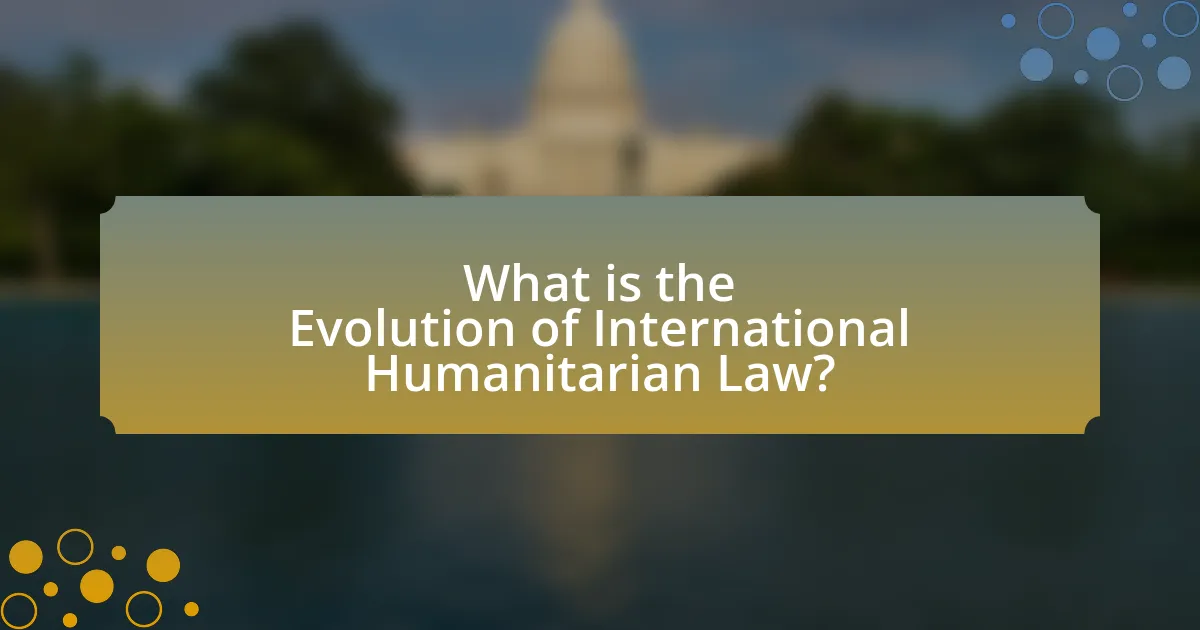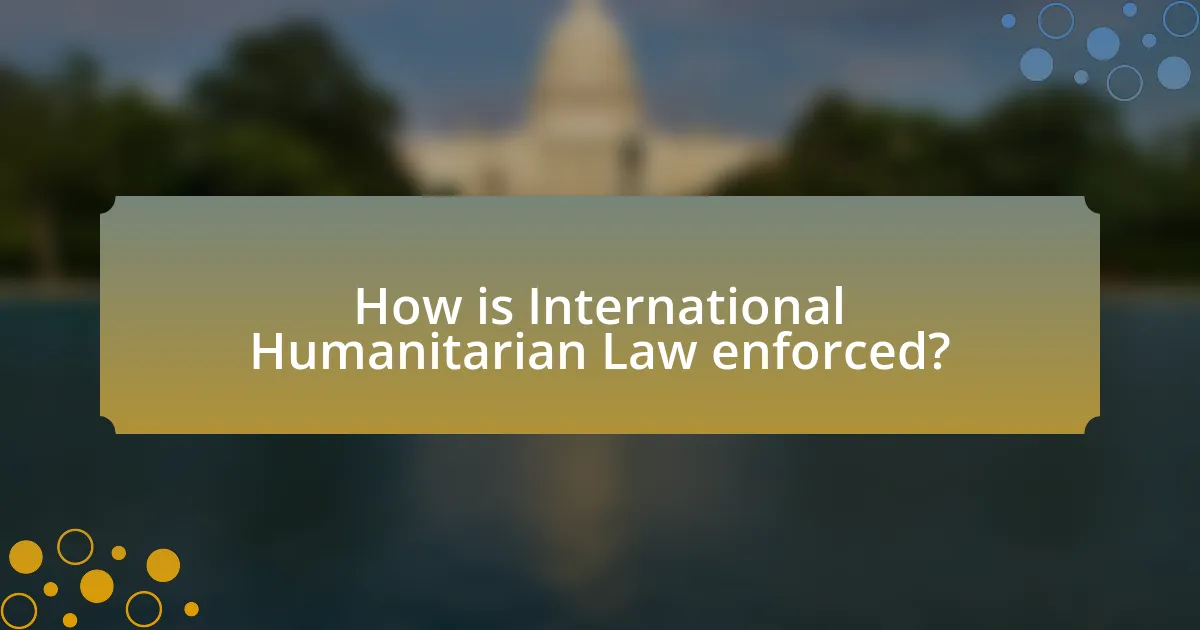The main entity of the article is International Humanitarian Law (IHL), which has evolved significantly since its inception in the mid-19th century, primarily through the Geneva Conventions and subsequent treaties. The article outlines the historical events that influenced the formation of IHL, key treaties that shaped its development, and the principles that guide its application, such as distinction, proportionality, and necessity. It also examines the enforcement mechanisms of IHL, including the role of international courts and state parties, while addressing the challenges and limitations faced in ensuring compliance. Additionally, the article highlights the importance of training, education, and the contributions of non-governmental organizations in promoting adherence to IHL.

What is the Evolution of International Humanitarian Law?
The evolution of International Humanitarian Law (IHL) began in the mid-19th century, primarily with the establishment of the Geneva Conventions in 1864, which aimed to protect wounded soldiers and establish humane treatment during war. This foundational framework was expanded through subsequent treaties, including the Hague Conventions of 1899 and 1907, which addressed the conduct of warfare and the protection of civilians. The development of IHL continued throughout the 20th century, particularly after World War II, with the adoption of the four Geneva Conventions in 1949 and their Additional Protocols in 1977, which further enhanced protections for victims of armed conflict. These legal instruments reflect a growing recognition of the need to limit the effects of armed conflict on individuals and to ensure accountability for violations. The establishment of international tribunals, such as the International Criminal Court, has also played a crucial role in enforcing IHL and holding perpetrators accountable, marking a significant advancement in the evolution of humanitarian law.
How has International Humanitarian Law developed over time?
International Humanitarian Law (IHL) has developed significantly over time, evolving from early customary practices to a comprehensive legal framework. Initially, IHL emerged in the 19th century with the establishment of the Geneva Conventions, which aimed to protect wounded soldiers and civilians during armed conflicts. The first Geneva Convention was adopted in 1864, and subsequent conventions expanded protections to include prisoners of war and civilians, culminating in the four conventions of 1949.
The development of IHL continued with the adoption of Additional Protocols in 1977, which further clarified the rules of warfare and enhanced protections for victims of conflicts. The establishment of international tribunals, such as the International Criminal Court in 2002, marked a significant advancement in enforcing IHL, holding individuals accountable for war crimes and crimes against humanity.
These milestones illustrate the progressive nature of IHL, reflecting the international community’s commitment to humanitarian principles and the protection of human rights during conflicts.
What historical events influenced the formation of International Humanitarian Law?
The formation of International Humanitarian Law (IHL) was significantly influenced by historical events such as the Napoleonic Wars, the establishment of the Geneva Conventions, and the aftermath of World War II. The Napoleonic Wars (1803-1815) highlighted the need for rules governing warfare, leading to the first formal codification of military conduct. The Geneva Conventions, particularly the first in 1864, established fundamental principles for the humane treatment of wounded soldiers and laid the groundwork for modern IHL. Additionally, the atrocities of World War II prompted the international community to create more comprehensive legal frameworks, culminating in the Geneva Conventions of 1949 and the Additional Protocols of 1977, which expanded protections for victims of armed conflict. These events collectively shaped the principles and regulations that define IHL today.
How have key treaties shaped the evolution of International Humanitarian Law?
Key treaties have significantly shaped the evolution of International Humanitarian Law (IHL) by establishing fundamental principles and frameworks for the protection of individuals during armed conflicts. The Geneva Conventions of 1949, for instance, codified rules regarding the treatment of wounded soldiers, prisoners of war, and civilians, thereby setting a standard for humane conduct in warfare. Additionally, the Additional Protocols of 1977 expanded protections to include non-combatants and established guidelines for the conduct of hostilities, reflecting the changing nature of warfare and the need for enhanced protections. These treaties have been instrumental in promoting accountability and compliance among states, as evidenced by the establishment of international tribunals that enforce IHL, such as the International Criminal Court, which prosecutes war crimes and crimes against humanity.
Why is the evolution of International Humanitarian Law significant?
The evolution of International Humanitarian Law (IHL) is significant because it establishes legal frameworks that protect individuals during armed conflicts. These frameworks, such as the Geneva Conventions, have been developed over time to address the changing nature of warfare and to ensure humanitarian protections for civilians and combatants alike. Historical events, such as World War II and the subsequent Nuremberg Trials, highlighted the need for comprehensive legal standards, leading to the establishment of IHL as a critical component of international law. The significance of IHL’s evolution is further underscored by its role in promoting accountability for war crimes and protecting human rights, thereby contributing to global peace and security.
What impact has International Humanitarian Law had on armed conflicts?
International Humanitarian Law (IHL) has significantly impacted armed conflicts by establishing legal frameworks that protect individuals who are not participating in hostilities and restrict the means and methods of warfare. IHL, through treaties such as the Geneva Conventions, has led to the development of norms that aim to minimize suffering during conflicts, ensuring that civilians and combatants are treated humanely. For instance, the Geneva Conventions of 1949 and their Additional Protocols have been ratified by 196 countries, demonstrating widespread acceptance and commitment to these humanitarian principles. This legal framework has also facilitated accountability for war crimes, as seen in tribunals like the International Criminal Court, which prosecutes individuals for violations of IHL. Consequently, the enforcement of IHL has contributed to a gradual reduction in the brutality of warfare and has promoted the protection of human rights in conflict situations.
How does the evolution of International Humanitarian Law reflect changes in societal values?
The evolution of International Humanitarian Law (IHL) reflects changes in societal values by increasingly prioritizing human rights and the protection of individuals during armed conflicts. Initially focused on the conduct of warfare and the treatment of combatants, IHL has expanded to encompass the protection of civilians, women, and children, demonstrating a societal shift towards valuing human dignity and welfare. For instance, the Geneva Conventions of 1949 and their Additional Protocols emphasize the need to protect non-combatants, which aligns with the growing global consensus on human rights. Furthermore, the establishment of the International Criminal Court in 2002 illustrates a commitment to accountability for war crimes, reflecting a societal demand for justice and the rule of law in conflict situations.

What are the key principles of International Humanitarian Law?
The key principles of International Humanitarian Law (IHL) are distinction, proportionality, and necessity. Distinction mandates that parties in a conflict must differentiate between combatants and non-combatants, ensuring that military operations target only legitimate military objectives. Proportionality prohibits attacks that would cause excessive civilian harm in relation to the anticipated military advantage. Necessity allows for the use of force only when it is essential to achieve a legitimate military objective. These principles are codified in treaties such as the Geneva Conventions and are fundamental to protecting human rights during armed conflicts.
What are the fundamental principles that guide International Humanitarian Law?
The fundamental principles that guide International Humanitarian Law (IHL) are distinction, proportionality, and necessity. Distinction requires parties to a conflict to differentiate between combatants and civilians, ensuring that civilian populations are protected from the effects of hostilities. Proportionality prohibits attacks that would cause excessive civilian harm in relation to the anticipated military advantage gained. Necessity allows for the use of force only when it is essential to achieve a legitimate military objective. These principles are enshrined in various treaties, including the Geneva Conventions, and are supported by customary international law, reinforcing their validity and application in armed conflicts.
How do the principles of distinction and proportionality apply in conflict situations?
The principles of distinction and proportionality are fundamental in conflict situations, guiding the conduct of hostilities to protect civilians and civilian objects. The principle of distinction mandates that parties to a conflict must differentiate between combatants and non-combatants, ensuring that attacks are directed solely at military objectives. This principle is enshrined in Article 48 of Additional Protocol I to the Geneva Conventions, which emphasizes the necessity of distinguishing between civilian and military targets to minimize civilian harm.
The principle of proportionality, on the other hand, prohibits attacks that may cause excessive civilian harm in relation to the anticipated military advantage gained. This principle is articulated in Article 51(5)(b) of Additional Protocol I, which states that an attack is considered indiscriminate if it causes incidental loss of civilian life or injury to civilians that would be excessive compared to the concrete and direct military advantage anticipated.
Together, these principles aim to limit the effects of armed conflict, ensuring that military operations are conducted with a focus on humanitarian considerations, thereby reinforcing the legal framework established by international humanitarian law.
What role does the principle of necessity play in military operations?
The principle of necessity in military operations dictates that force may only be used to achieve a legitimate military objective and must be necessary to secure that objective. This principle ensures that military actions are proportionate and justified, preventing unnecessary suffering and destruction. For example, the Geneva Conventions emphasize that military operations must distinguish between combatants and non-combatants, reinforcing the necessity to limit harm to civilians. This principle is foundational in international humanitarian law, guiding military conduct to align with ethical standards and legal obligations during armed conflict.
How do these principles protect individuals during armed conflicts?
International humanitarian law (IHL) principles protect individuals during armed conflicts by establishing rules that limit the effects of armed violence on people and property. These principles, such as distinction, proportionality, and necessity, ensure that combatants differentiate between military targets and civilians, thereby minimizing civilian casualties. For instance, the principle of distinction mandates that parties to a conflict must always distinguish between combatants and non-combatants, as outlined in Article 48 of Additional Protocol I to the Geneva Conventions. This legal framework is designed to safeguard those who are not participating in hostilities, including civilians and medical personnel, thereby reinforcing their protection under international law.
What protections are afforded to civilians under International Humanitarian Law?
Civilians are afforded specific protections under International Humanitarian Law (IHL), primarily through the Geneva Conventions and their Additional Protocols. These protections include the prohibition of direct attacks against civilians, the requirement to distinguish between combatants and non-combatants, and the obligation to take all feasible precautions to minimize harm to civilians during military operations. Additionally, IHL mandates the humane treatment of all individuals who are not participating in hostilities, including the wounded, sick, and shipwrecked, as well as those who are detained. The legal framework is designed to ensure that civilians are shielded from the effects of armed conflict, reflecting the principles of necessity and proportionality in military actions.
How does International Humanitarian Law safeguard the rights of prisoners of war?
International Humanitarian Law (IHL) safeguards the rights of prisoners of war (POWs) primarily through the Third Geneva Convention, which outlines specific protections and humane treatment standards. This legal framework mandates that POWs must be treated humanely, protected against violence, intimidation, and public curiosity, and provided with adequate food, water, and medical care. Additionally, IHL prohibits torture and inhumane treatment, ensuring that POWs retain their rights to fair trial and communication with their families. The enforcement of these provisions is supported by international mechanisms, such as the International Committee of the Red Cross, which monitors compliance and advocates for the rights of POWs during armed conflicts.

How is International Humanitarian Law enforced?
International Humanitarian Law (IHL) is enforced through a combination of national and international mechanisms, including the prosecution of war crimes, the role of international courts, and the implementation of treaties by states. National courts can prosecute individuals for violations of IHL, while international tribunals, such as the International Criminal Court (ICC), hold individuals accountable for war crimes, genocide, and crimes against humanity. Additionally, states are obligated to incorporate IHL into their domestic laws and ensure compliance through military training and legal frameworks. The Geneva Conventions, which form the core of IHL, require signatory states to enact legislation to punish violations, thereby reinforcing enforcement at the national level.
What mechanisms exist for the enforcement of International Humanitarian Law?
The mechanisms for the enforcement of International Humanitarian Law (IHL) include international treaties, national legislation, and judicial bodies. International treaties, such as the Geneva Conventions, establish legal obligations for states and parties involved in armed conflicts. National legislation allows countries to incorporate IHL into their domestic legal systems, enabling prosecution of violations. Judicial bodies, including the International Criminal Court (ICC) and ad hoc tribunals, provide platforms for holding individuals accountable for war crimes and other serious breaches of IHL. These mechanisms collectively aim to ensure compliance and accountability in the enforcement of humanitarian principles during conflicts.
How do international courts and tribunals contribute to enforcement?
International courts and tribunals contribute to enforcement by adjudicating disputes and ensuring compliance with international law. They provide a legal framework for addressing violations of humanitarian law, such as war crimes and genocide, through binding decisions that member states are obligated to follow. For instance, the International Criminal Court (ICC) prosecutes individuals for serious offenses, thereby deterring future violations and promoting accountability. Additionally, the rulings of these courts can lead to reparations for victims and influence national legal systems to align with international standards, reinforcing the enforcement of humanitarian law globally.
What role do state parties play in the enforcement of International Humanitarian Law?
State parties are crucial in the enforcement of International Humanitarian Law (IHL) as they are responsible for implementing and ensuring compliance with IHL treaties within their jurisdictions. They must incorporate IHL into national legislation, train armed forces, and establish mechanisms for accountability, such as prosecuting war crimes. For instance, the Geneva Conventions obligate state parties to enact laws that penalize violations, demonstrating their role in both prevention and enforcement. Additionally, state parties are required to cooperate with international bodies, such as the International Criminal Court, to uphold IHL standards, further solidifying their enforcement responsibilities.
What challenges are faced in the enforcement of International Humanitarian Law?
The enforcement of International Humanitarian Law (IHL) faces significant challenges, primarily due to issues of compliance, accountability, and the political dynamics of armed conflicts. Non-state actors, such as insurgent groups, often do not recognize IHL, complicating enforcement efforts. Additionally, states may lack the political will to prosecute violations, as seen in conflicts where governments are implicated in war crimes, leading to a culture of impunity. Furthermore, the lack of effective mechanisms for monitoring and enforcing compliance, such as independent international courts, hampers accountability. Historical examples, such as the Rwandan Genocide in 1994, illustrate the failure to enforce IHL, where the international community’s inaction allowed widespread atrocities to occur. These factors collectively undermine the effectiveness of IHL in protecting civilians and ensuring humane treatment during conflicts.
How do political considerations impact the enforcement of International Humanitarian Law?
Political considerations significantly impact the enforcement of International Humanitarian Law (IHL) by influencing states’ willingness to comply with legal obligations during armed conflicts. For instance, powerful nations may prioritize strategic interests over humanitarian principles, leading to selective enforcement of IHL. Historical examples include the lack of accountability for war crimes in conflicts where geopolitical interests are at stake, such as the U.S. involvement in Iraq, where allegations of violations were often overshadowed by political alliances. Additionally, the United Nations Security Council’s decisions, often driven by political agendas of its permanent members, can hinder the enforcement of IHL, as seen in the Syrian conflict, where political divisions have obstructed effective intervention and accountability measures.
What are the limitations of current enforcement mechanisms?
Current enforcement mechanisms for international humanitarian law face significant limitations, including lack of universal jurisdiction, insufficient resources, and political bias. These mechanisms often rely on state cooperation, which can be inconsistent, leading to gaps in accountability. For instance, the International Criminal Court (ICC) has limited jurisdiction and can only prosecute crimes committed in member states or by nationals of member states, restricting its reach. Additionally, enforcement bodies often lack adequate funding and personnel, hindering their ability to investigate and prosecute violations effectively. Political considerations can also influence enforcement actions, as powerful states may evade accountability due to their influence in international relations.
What best practices can enhance the enforcement of International Humanitarian Law?
Best practices that can enhance the enforcement of International Humanitarian Law (IHL) include strengthening accountability mechanisms, increasing training for military and law enforcement personnel, and fostering international cooperation. Strengthening accountability mechanisms, such as establishing war crimes tribunals, has proven effective in holding violators accountable, as seen in the International Criminal Tribunal for the former Yugoslavia, which successfully prosecuted numerous war crimes. Increasing training for military personnel on IHL ensures that they understand their obligations, which is critical; for instance, the International Committee of the Red Cross provides extensive training programs that have been shown to improve compliance. Lastly, fostering international cooperation through treaties and agreements, such as the Geneva Conventions, enhances collective enforcement efforts, as countries are more likely to act against violations when they are part of a unified international framework.
How can training and education improve compliance with International Humanitarian Law?
Training and education can significantly improve compliance with International Humanitarian Law (IHL) by enhancing the understanding of legal obligations among military personnel and humanitarian workers. When individuals receive comprehensive training on IHL, they become more aware of the rules governing armed conflict, which can lead to better decision-making in complex situations. For instance, studies have shown that armed forces that implement regular IHL training programs report fewer violations during operations, as personnel are better equipped to recognize and adhere to legal standards. Additionally, educational initiatives that incorporate real-life scenarios and case studies can reinforce the importance of compliance, thereby fostering a culture of accountability and respect for human rights within military and humanitarian organizations.
What role do non-governmental organizations play in promoting adherence to International Humanitarian Law?
Non-governmental organizations (NGOs) play a crucial role in promoting adherence to International Humanitarian Law (IHL) by monitoring compliance, advocating for legal reforms, and providing education and training. NGOs such as the International Committee of the Red Cross (ICRC) actively monitor conflicts to ensure that parties adhere to IHL, documenting violations and holding violators accountable. Additionally, organizations like Human Rights Watch and Amnesty International advocate for stronger enforcement mechanisms and legal frameworks to protect civilians in armed conflicts. They also conduct training programs for military personnel and humanitarian workers to enhance understanding and implementation of IHL principles. This multifaceted approach by NGOs is essential for fostering a culture of respect for IHL and ensuring that humanitarian standards are upheld in conflict situations.


